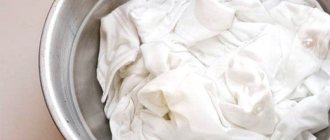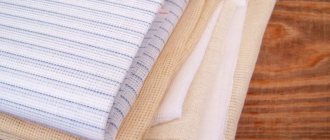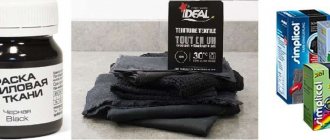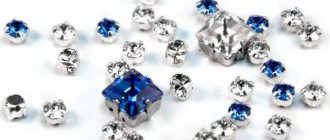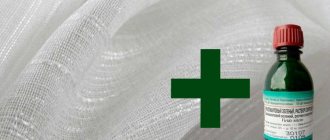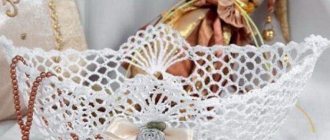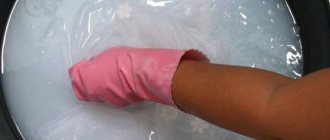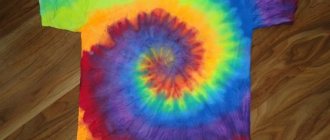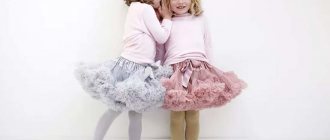Home textiles and some items of clothing sometimes have to be treated with starch to give them rigidity and a clear shape. In modern times this is done much less frequently than, for example, at the end of the last century. Starched items are much less susceptible to contamination and have a completely different appearance than simply washed items. Read more about how to starch bed linen, tulle, clothes, using or without a washing machine, in the text of this article.
Starched items look elegant, fresh and festive
Why starch bed linen?
Starched clothes and linen have some distinctive characteristics:
- textiles become noticeably denser, its fibers are strengthened;
- linen items have a pleasant crunch and smell good;
- the material practically does not wrinkle, maintaining the required shape;
- Even if the clothes were yellowed, they are bleached;
- Dirt is less absorbed into clothing.
Starch gives products a neater appearance and protects them from rapid contamination.
But it is not always worth starching bedding - starched fabric does not “breathe”, as its pores become clogged. This can create unpleasant sensations for the skin, promote the occurrence of fungus, mold, and the proliferation of pathogenic bacteria. It is for this reason that bed starch is very, very soft.
It is also undesirable to starch underwear and summer clothes, with the exception of some of their parts. Starch can change the shade of dark fabrics, but it does not “stick” to synthetic fabrics. Textile elements embroidered with floss threads can generally stick together and be hopelessly damaged by starch. Calico, cotton, satin, linen, chintz, cambric tolerate this process well.
How to make your own mixture
It is well known that fabric differs in structure, thickness and other properties. Based on this, clothes need to be starched in different ways, taking into account the characteristics of the selected textile.
Processing options: table
| View | What is it suitable for? | Recipe |
| Soft | Bed linen, curtains and thin fabrics (cambric, tulle, chiffon). | Dilute 1 tsp in 1 liter of water. starch. Stir until the lumps disappear. |
| Average | Shirts, tablecloths, lace items, bows, napkins, robes. | The amount of substance for the same volume of liquid is greater - 1 tbsp. |
| Hard | Collars, cuffs and other parts that need a stable shape. It is not recommended to completely cover the item with such a thick film. | For 1 liter of water you will need 2 tbsp. starch. Dissolve until smooth. Dilute 1 tsp in a small amount of hot liquid. and add to the solution. Mix thoroughly until a homogeneous consistency is obtained. Let it brew for 2 hours. |
Tip: you can use not only potato starch, but also corn, rice or wheat starch. The product obtained from tubers is especially popular because it thickens well.
How bedding was starched in the last century
In the last twentieth century, bed linen, table linen, and clothing were processed mainly independently, at home, with various types of starch:
- potato;
Potato starch is a free-flowing powder that is colored white. - wheat;
Wheat starch grains are round or elliptical in shape
- rice;
Rice starch is a soft white powder consisting of small particles only a few microns in size - corn;
Corn starch is much softer than potato starch and can dissolve even in cold water - barley.
There are different types of starch:
- soft – underwear, bed linen, summer dresses, curtains;
- medium – used for men’s shirts, table linen, textile napkins;
- hard - exclusively for collars, cuffs, parts of fancy dress.
To treat laundry with starch at home, you need to brew the starch in the correct proportion
It makes no difference which starch is used, the only difference is in the concentration. In the last century, every woman had to be able to starch clothes - there were no special products for sale for various textile materials, and not everyone had a washing machine.
Starch the traditional way
You can give your linen incredible freshness and “squeaky” cleanliness using the classic method of starching, which our grandmothers told us about. To carry out the procedure manually, at home, you should perform the following sequence of actions:
- Place the washed items in a basin with a cool starch solution (not hotter than 35 °C);
- leave the products in the container for 15-20 minutes. If you don’t have that much time, you can simply rinse your clothing or bedding thoroughly in the solution;
- lightly wring out the laundry and shake it to prevent wrinkles from forming on the fabric;
- dry the products.
Ironing starched clothes or bedding is done when the linen is slightly damp . It is important to set the minimum heating temperature for the soleplate of the iron; this measure will prevent the fabric from sticking to the metal.
If the traditional starching procedure seems too complicated, you can use another method. Prepare a weak paste, pour the liquid into a spray bottle and spray the laundry that has already been cleaned and prepared for ironing. This method will take much less time and will simplify starching of large items.
How to starch bed linen and tulle at home
Starched bed linen wrinkles less and washes better.
Bedding, as well as most types of tulle and curtains, are starched softly, after having been washed and thoroughly wrung out.
Tulle takes on a more attractive appearance after the starching process
Then prepare this solution:
- composition of the mixture – one teaspoon of starch per liter of cold water;
- First, the starch is diluted in a small container, poured with two glasses of water;
- the more laundry you need to starch, the more such liquid is prepared;
- stir so that the consistency is homogeneous, without lumps;
- then put the water on to warm up - as much as is needed for rinsing;
- after boiling, pour the starch solution from a small container into the water and mix;
- the composition is cooled - the result should be “slippery” water, denser than usual;
- Rinse the bedding in the mixture described above for several minutes, tulle for up to half an hour.
Traditional starch mixture made from potato starch
Before hanging to dry, do not twist the bedding - let it sag a little, after which you can lightly wring it out. Before drying, it is important to shake the fabric, straighten it well, and it is better to iron the starched fabric while still slightly damp.
To starch an already dry fabric, the liquid described above is put into a spray bottle and the clean textile is treated. This process significantly saves time and effort.
You can lightly starch the material by ironing it through gauze soaked in a weak starch solution
Choosing the right starch product
Traditionally, the starch mixture is prepared using potato starch. It is very easy to use, brews well, and has a beautiful white or pale blue tint. The only thing you need to remember is that improper brewing of starch can turn the fabric yellowish.
Article on the topic: Why the Samsung washing machine jumps
Corn starch also does the job well. It does not leave streaks and thickens quickly enough, but to completely prepare the starch mixture, it must be boiled for at least 5 minutes.
If you don’t have the desire or time to prepare a starch solution with your own hands, the necessary product can be easily purchased at a hardware store. Liquid mixtures with a starching effect are added during the rinsing process. Aerosol and spray are used during ironing of the product, strictly adhering to the manufacturer's instructions.
How to starch shirts at home
Starched items look quite festive, but do not allow air to pass through well, so they are not suitable for constant wear.
A high-quality starched shirt emphasizes the status of the owner, giving him elegance. The method described below is suitable for both women's and men's shirts:
- prepare a medium-hard solution of starch or a purchased synthetic product;
- the composition is thoroughly mixed in a basin so that there are no lumps; it is filtered through several layers of gauze;
- the shirt is placed in the mixture for about fifteen minutes;
- then the product is lightly wrung out;
- To prevent the shirt from becoming deformed, it is dried on hangers - preference is given to wide ones;
- It is not recommended to dry it completely; iron the item slightly damp, since yellow spots often appear on overdried ironing.
Particular attention must be paid to the collar and cuffs - these parts are starched separately, using the harshest solution, and ironed, giving them a strong stand.
If you only need to starch the collar or cuffs of a shirt, it is better to use a spray bottle or brush
Advice from experienced housewives
Before you starch your sleeping accessories in a washing machine or manually, you should find out which fabrics can and cannot be soaked in paste. It is strictly forbidden to process products made of silk or synthetic materials. Only natural linen, cotton, chintz underwear, as well as items made from calico and satin, are allowed to be starched.
An ideal starch paste, which can be used both for manual processing and for automatic washing, is prepared according to the following rules:
- Dissolve half a teaspoon of starch in a liter of cold water. Stir until there are no lumps;
- in another saucepan, bring clean water to a boil and pour starch “milk” into it in a thin stream, while stirring the solution;
- Reduce the heat on the burner and cook the paste over low heat for another 5-10 minutes. The starch solution will be similar in consistency to jelly;
- wait until the paste cools down;
- If you find lumps in the solution, strain it using gauze or a strainer.
Before starching, the paste should be diluted with clean water to the desired consistency. If you want to give your bed linen a soft blue tint, you can add a little blue to the starch solution.
A spoonful of salt mixed into a starch solution will give your sleeping accessories a glossy shine. The shine of the bedding will be guaranteed. You can prevent the iron sole from sticking to starched sheets by first pouring 3 drops of turpentine into the paste.
How to starch things from different types of fabric
Knitted fabric is also treated gently, but it should be dried exclusively on a horizontal surface, otherwise the product will stretch and lose its shape. For knitted products, giving them rigidity, it is recommended to treat them with a gelatin mixture:
- pour a large spoonful of gelatin into half a glass of water and heat in a water bath until completely dissolved;
- then add another glass of water;
- the product is impregnated with the resulting solution.
Ready-made gelatin solution - express starching
This composition is also used for lace napkins, textile flowers and other similar decor. Starch is not suitable for processing dark or colored fabrics, as it leaves whitish spots. The following adhesive composition is recommended for such fabrics:
- depending on the purpose of the textile material, soft or hard processing is performed;
- for soft processing, PVA glue is diluted with warm water in a ratio of one to one, for the hard version - in a concentration of two to one;
- The fabric is placed in the solution, after complete soaking, it is removed and wrung out.
You can starch clothes with PVA glue; to do this, you need to dilute it with water.
This method is not suitable for underwear or excessively large items. There is also sugar syrup treatment:
- six to seven tablespoons of sugar are boiled in a liter of water;
- textiles are placed in a hot solution, soaked, and squeezed out;
- there is one drawback - the “sweet” fabric will attract insects.
You can also starch things with ordinary white sugar.
To starch the most delicate silk fabric, a solution of gelatin and silicate glue is suitable - in this case, dilute one spoon per five liters, soak the product, and squeeze it out a little. After processing, silk acquires elasticity and a beautiful shine.
When you need to starch thin and delicate fabric, use a weak solution
Tulle is used for sewing elegant dresses and ballet tutus. It will require a medium-hard starch solution - two teaspoons per liter of water. The product is thoroughly soaked, removed, and straightened.
For stiffness, the petticoat needs two tablespoons of starch per liter of water.
Multi-layer gauze products are processed in the most harsh ways - at least two large spoons of starch and a small spoon of sodium boric salt are added to one liter of water, the product is immersed there, and when it is sufficiently saturated, squeezed out.
You can starch knitted napkins and a school white apron with numerous laces using a medium-hard solution.
Openwork products made from fine yarn are kept in starch liquid for 5-10 minutes
The product is pre-washed by machine or by hand, placed in a starch mixture for twenty minutes, removed, no need to wring out the apron. As an option, a freshly washed apron is simply sprayed with a solution from a spray bottle or blotted with a wet starchy cloth.
The embroidery canvas is starched to simplify the process of embroidering on it. To do this, the textiles are placed in a hard starch solution for about fifteen minutes and wrung out well. The already embroidered fabric is pre-washed and impregnated with a medium-hard composition for no more than fifteen minutes.
To starch expensive fabrics with bright, rich colors and complex textures, it is better to use a ready-made product
Types of starching
There are three types of starching, which vary depending on the intensity of the procedure:
- Soft starching,
- Medium starching
- Hard starching.
For example, underwear, bed linen, bedding, light blouses and dresses are softly or very softly starched; Men's shirts and tablecloths are moderately starched, but hard starching is used in the case of partial processing - for cuffs, collars and other elements of clothing. At the same time, the amount of starch per liter of water varies.
How to starch bedding and clothes in a washing machine
To starch things in the washing machine, you need to add a small amount of adhesive liquid to the conditioner compartment and start the usual washing cycle. Ready-made
starch compositions are sold in household chemical stores - some are applied to the fabric before ironing, others during washing. Starching bedding and linen in the washing machine is as easy as shelling pears:
- to begin with, prepare a “soft” starch solution according to the above-described scheme;
- the composition is poured into the engine compartment for the air conditioner;
- The washing machine toggle switch is set to rinse mode;
- after the process is completed, the laundry is taken out, shaken, and dried;
- The machine is wiped from the inside and ventilated.
When starching in a washing machine, special synthetic liquids are often used, for example, based on polyvinyl acetate, which cope with the task no worse. Additionally, you should not use any conditioners.
A starch agent that is added directly during washing
To starch clothes and table linen made from various types of fabric, a solution of the required composition and concentration is prepared and poured into the machine as described above.
How can starch harm you?
Some experienced housewives do not recommend starching laundry either in a washing machine or by hand. Their fears are truly justified. When bed linen is starched, air does not pass through the fabric well because the spaces between the fibers become clogged with the substance.
As a result, the fabric does not absorb moisture well and does not allow the body to breathe. This contributes to feelings of discomfort during sleep. In addition, there is a high probability of mold or mildew formation. Therefore, it is highly undesirable to starch bedding.
How to iron and dry starched items
Dry the fabric until it becomes slightly damp, then begin ironing
All fabrics are ironed while still wet, on both sides, but in slightly different ways:
- silk - through smooth fabric;
- tulle - ironed while wet, straightening the folds;
- embroidered products - only on the reverse side;
- lace - through smooth fabric or gauze;
- gauze - iron damp, straighten folds immediately;
- A white school apron is ironed with a warm iron.
If you first add a little salt to the starch solution, the fabrics will not stick to the iron and will acquire a unique shine.
They should also be dried differently:
- a silk blouse and dress are carefully hung on hangers;
- tulle, gauze are dried in a straightened form;
- a lace school apron is dried by laying it out on a horizontal surface;
- embroidery canvas is also dried horizontally;
- Thin embroidered napkins or lace are dried on a towel, pinned with invisible edges, and straightened.
Any starched items should not be dried in the cold or in direct sunlight.
Spray for applying starch before ironing
Classic starching method
Previously, our grandmothers and mothers starched bed linen by hand. This treatment gave sheets, pillowcases and duvet covers a sparkling, squeaky clean finish. Surely, many remember how sweet it was to fall asleep on a pillow that smelled of freshness. The algorithm of actions for manual starching of linen is as follows:
- Soak clean, washed sets in a basin with a starch composition (the paste should be cooled to a temperature of 25-35°C);
- leave the bedding in this position for 20 minutes;
- gently wring out the laundry, shake it well - this way you can avoid the appearance of folds and creases on the fabric;
- dry your sleeping gear.
You should iron starched items when they are slightly damp. It is necessary to set the iron heat to minimum. This way, the sole of the device will not stick to the material.
If you don’t have time to soak the kits in paste, you can go the other way. Prepare a diluted starch solution and pour it into a spray bottle. Use a spray bottle to spray the bedding before ironing. This method will not require much time and will allow you to quickly process large duvet covers and sheets.

